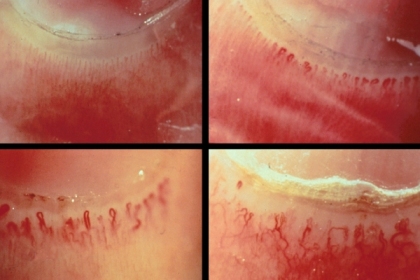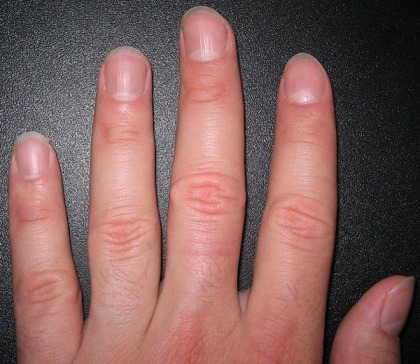Guinness World Records Book 2012 – Chris Walton has the longest fingernails: almost 20 feet!
September 18, 2011

Chris Walton, a budding singer from Las Vegas, hasn’t cut her nails in the past 18 years – resulting in fingernails total nearly 20 feet! Guinness Records announced a few days ago that Walton will receive a notification in the 2012 edition of the Guinness Book of World Records!
Walton’s fingernails are in total 19 feet + 9 inches long. An impression from Chris Walton’s life:
“The hardest thing for me to do is dig in my pockets,” the 45-year-old rock singer from Las Vegas says. “Everything else I can do myself — driving, shopping, cleaning the house … although when I vacuum, the cord gets tangled in my fingers.”
The previous record holder for longest nails was Lee Redmond of Salt Lake City. Her nails measured a total of 28 feet in 2008, but the following year, she lost her nails in a car crash.
The full story about Chris Walton:
Chris Walton has the longest fingernails!

NEW NAIL ART TREND – Celebrities using Stiletto Fingernails!
August 29, 2011
Are you tired of the squared down nail shape and want to update to something new? If so, check out the new celebrity favorite, the pointy shaped nails!
The newest nail art trend sported by the hottest Hollywood Divas (and spotted by: BecomeGoreous.com) is the stiletto/pointy shaped nails trend which is characterized by a lovely pointy shape that elongate fingers. Although the shape of your nails might seem like an unimportant thing, it is not, as nail shape can transform the aspect of your hands instantly and completely.
Let’s take a look at some recent impressions of the hands of various celebrities – including: Lady Gaga, Beyonce Knowles, Rihanna & Fergie long pointy fingernails.
– Lady Gaga’s stiletto fingernail art –


– Beyonce Knowles’s long pointy fingernails –


– Rihanna’s long pointy fingernails –


– Fergie’s long pointy fingernails –


NAIL ART ANIMATION – The Kia Picanto 2011 TV ad!
August 18, 2011
Fact or fiction? They say that the Kia Picanto TV ad required 9.000 nails make up to make the spot.
As part of the marketing for its new Picanto, the latest version of its smallest model, Kia came up with the world’s first nail-art stop-motion animation film. That’s right, it put together a micro-nail animation that celebrates the micro features of the car – with 1,200 bottles of nail polish, two hours of painting per nail, and 25 days and nights to complete all the work. Interesting and also weirdly Kia in its quirkiness, the little animation is sure to hit with the target market of city-dwelling ladies who like cute, zippy cars in candy colors.
Fact or fiction… ? Decide yourself!
More hand art is available at:
http://www.handresearch.com/hand/Evolutie/kunstEngels.htm
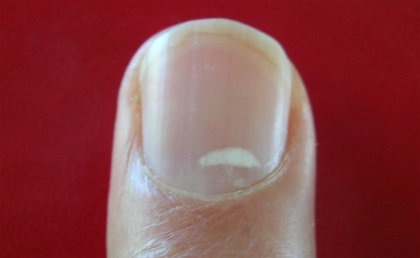
White spots on the fingernails belong to the most common ‘nail abnormalities’. Many people associate these whith spots with a calcium deficiency. However, the truth is that usually they do not relate to any’ health’ problem at all! A white spot is usually caused by a minor finger-related trauma!
In medical sciences a white spot on a fingernail is known as ‘leukonychia punctata’ – this name relates to the availability of nucleated keratinocytes.
NOTICE: A narrow white line in the nail – a.k.a. ‘transverse leukonychia’ – is another type of nail disorder.
White spots are typically caused by random minor trauma – including: pushing nail cuticles, or ‘nervous’ cuticle picking! This explains why white spots in nails are often seen in the hands of children!
White spots & zinc deficiency?
 Despite that white spots are usually the result of a minor physical trauma, studies have shown that sometimes white spots can be the result of a zinc deficiency – so that should not be confused with the unfounded folklore tail that white spots in a fingernail might indicate a calcium deficiency! (See for example: Fingernail white spots: possible zinc deficiency)
Despite that white spots are usually the result of a minor physical trauma, studies have shown that sometimes white spots can be the result of a zinc deficiency – so that should not be confused with the unfounded folklore tail that white spots in a fingernail might indicate a calcium deficiency! (See for example: Fingernail white spots: possible zinc deficiency)
Interestingly, in this perspective there even appears to be a connection between zinc definciency & trauma: stress! And in the field of palm reading professional palm readers have observed that white spots typically manifest in the fingernails when people experience a higher amount of stress than they usually do.
But in general, one should not expect to find a zinc deficiency when a person has only a few white spots. Because actually, a number of conditions can arise from a lack of zinc. One of the most important, which also lead to its discovery, was the stunting of growth and the lack of sexual development in adolescent boys; adding zinc to the diet brought about a rapid improvement. Skin complaints such as dermatitis and a condition called acrodermatitis in babies may result from deficiency, and there may be slow healing of burns and wounds. So zinc deficiency may show up as white spots or bands on fingernails, but probably only when other conditions manifest as well!
More details are discussed in the following topic at the Modern Hand Reading Forum:
http://www.modernhandreadingforum.com/t201p15-white-spots-on-nails-leukonychia
White spots & calcium deficiency?
 This part of the ‘folklore’ is not true. The Asia Pacific Journal of Clinical Nutrition reports:
This part of the ‘folklore’ is not true. The Asia Pacific Journal of Clinical Nutrition reports:
“There is no evidence to support a relationship between the white flecks and calcium or any other nutritional deficiency. Of course it is possible that people who have white flecks in their fingernails may coincidentally be deficient in calcium. White spots in fingernails may result from minor damage caused by bumping the nails into hard surfaces like bench tops or machinery. These white flecks are different from the white bands that are observed in nails of some undernourished children in developing countries, and in people who have low blood protein levels for various reasons.”
Conclusion: white spots do NOT indicate a calcium deficiency!
SUGGESTION FOR FURTHER READING:
• What are the most common nail disorders?
• Fingernail disorders & medical hand analysis!
Visibility of Blood Vessels in the Proximal Nailfold is a Biological Marker for Schizophrenia!
June 16, 2011
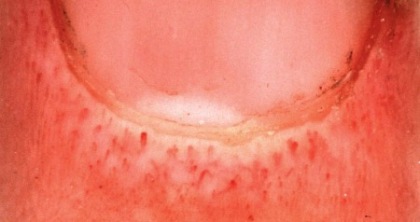
Visibility of the nailfold blood vessels plexus has been known for a long time as a biological marker in schizophrenia.
Schizophrenia became known for a high occurence of minor physical anomalies (MPA’s). Interestingly, one of the typical MPA’s in schizoprenia concerns visibility of the blood vessels in the proximal nailfold – a.k.a. ‘nailfold plexus visibility’ (NPV – which requires the use of a microscope for proper assessment). It concerns a minor developmental abnormality that has been studied as a hand marker for schizophrenia, but which lies outside the scope of the traditional MPA construct. Because nail fold plexus is commonly seen in the hands of young children, but not in adults. The statistics show that a high level of nailfold plexus visibility is relatively rare in the general population (occurring in 3-7% of healthy adults) while the rate of high NPV ranges from 20-70% in populations with schizophrenia (Curtis et al., 1999).
Interestingly, over the years studies have suggested this hand characteristic is specificly related to the so-called ‘negative symptoms’ in schizophrenia (which are associated with deficits of normal emotional responses or of other thought processes). And EEG studies have revealed that this nail fold blood vessel condition may mark a process associated with abnormal brain development leading to schizophrenia – including: an inverse relationship between plexus visibility and lateral ventricle size in the brain. The PVS is reliably determined and stable over time. Interrater reliabilities for PVS reportedly range from .83 to .99 (Buchanan and Jones 1969; Maricq 1966).
Taken together, researchers have concluded that findings on MPAs indicate that these minor anomalies appear to be part of some schizophrenia syndromes, representing a stable systemic or physical set of manifestations of the underlying neurodevelopmental processes that lead to the illness. This might explain why in the DSM-V the term ‘schizophrenia’ may be get replaced by the name ‘psychosis risk syndrome‘.
 BLOOD SUPPLY IN THE SKIN:
BLOOD SUPPLY IN THE SKIN:
The skin has a profuse blood supply, which is important in temperature regulation. The subcutaneous arteries form a network in the subcutaneous tissue, and from this is derived a subpapillary plexus in the dermis. Capillary loops in the dermal papillae arise from the subpapillary plexus, and from these loops the avascular epidermis is bathed in tissue fluid. A subpapillary plexus of venules gives the skin its pink color: the vessels become dilated when the skin is heated, and thereby make it look red.
NAILFOLD PLEXUS VISIBILITY & PSYCHOPATHOLOGY:
Just like is seen in the perspective of minor physical anomalies, nailfold plexia visibility is much more common in schizophrenia than in any other form of psychopathology. Studies have revealed that nailfold plexia visibility in schizophrenia is (much) more common than in other psychotic- & mood disorders – but these other disorders also show higher occurence than seen in the general population.
Studies have also shown that that patients with schizophrenia with a highly visible plexus have greater oculomotor dysfunction, negative symptoms, symptom severity, chronic course, and neuropsychological dysfunction. Furthermore, nailfold plexus visibility appears to be at least moderately heritable.
NAILFOLD PLEXUS & OTHER DISORDERS:
Other studies have revealed that nail fold plexus visibility has also been linked with hand markers in rheumatoid arthritis & hand markers in psoriasis. The pronounced subpapillary plexus visibility, greater number of vessels and their elongation are indicative of rheumatoid arthritis, while shorter, fewer capillaries and especially characteristic psoriatic capillaries, when present, suggest psoriatic arthritis.
Changes of nailfold capillary patterns have been described in certain patients with systemic sclerosis, dermatomyositis, mixed connective tissue disease, and Raynaud’s syndrome.
NOTICE: The nail tutor demonstrates how other nail fold characteristics can be associated with specific medical problems. More details about how to recognize various stages/variants of proximal nailfold blood vessels visibility in a palm reading, are presented in the picture below.
A phantom picture for the hand in schizophrenia is available here:
http://www.multiperspectivepalmreading.com/hands-schizophrenia-palm-reading.htm
Nailfold plexus changes are characterized by loss of (drop-out) nailfold capillary loops that surround the remaining, enlarged dilated capillaries. Upper left, A normal nailfold capillary pattern shows the uniform morphology and homogeneous disitribution of the small capillary loops just below the cuticle. Upper right, Capillaroscopy in a patient with systemic sclerosis illustrates dilatation of isolated capillary loops, with loss of surrounding loop structures. Lower right, The abnormal pattern is from a patient with childhood dermatomyositis. Dilated capillary loops are present, as well as areas of arborized clusters of capillary loops. Lower left, Distortion of the normal capillary loop architecture is seen in a patient with adult dermatomyositis. Note the loss of normal homogeneous distribution of the capillaries and the alterations in the morphology of the vessels, including the dilated and enlarged “giant” capillary loops.
Your fingernails are like the ‘rings of a tree’: they provide a window to changes in your body during the past six months. And fingernail changes likewise provide clues about changes in your health: because it takes about 6 months to grow out a full nail out of a finger (a fingernail grows about 0.1 mm per day).
How to recognize healthy fingernails? A healthy fingernail is characterized by: a smooth, rounded nail plate with a rectangular shape (at the corners slightly rounded). It’s color is pink, and at least the thumb requires to have a white crescent shaped lunula – in most people the lunula is not seen on the pinky fingers (some people have lunulae in all fingers where they take at most 1/3 of the pink area in the nail plate).
FINGERNAIL CHANGES:
Nail changes often reflect changes in the body. Medical science has identified & described literally hundreds different types of nail changes, and quite some of them have a highly significant correlation with the development of all kinds of diseases. But usually nail changes only rarely have a significance for a specified disease.
But nail changes can also indicate high stress, physical traumas, hormone changes, and even an unhealthy food pattern. But often it takes some time to monitor the nature of the changes seen in the nails!
And there Multi-Perspective Palm Reading can become involved, and even play a decisive role in the diagnosis process of the nail changes. Because Multi-Perspective Palm Reading describes the significance of nail changes in specified diseases, plus an overview of the other typical hand characteristics in those diseases. And therefore it can become very helpfull to find the true cause of nail changes when there are multiple options left according ‘the science of the fingernails’.
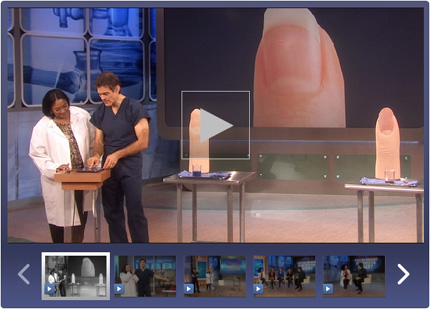 Dr. Oz – who became for his appearances in The Oprah Winfrey Show from 2004 until 2009, has presented a 6-minute Masterclass introduction to how your fingernails can provide you a window to your health, titled:
Dr. Oz – who became for his appearances in The Oprah Winfrey Show from 2004 until 2009, has presented a 6-minute Masterclass introduction to how your fingernails can provide you a window to your health, titled:

14 February- it’s Valentine’s Day! Did you succeed in preparing for Valentine’s Day? If you are still looking for a nice surprizing you might consider to surprize your love with a nice warm hand massage… or a beautiful nail design!
For many people goes the preperation for Valentine’s Day way beyond selecting a perfect gift present.
Let’s take a look at some spectacular nail designs, because for many women the tips of the fingernails are absolutely essential. Check out a few of these nail designs, and if it’s too later for this year… how about next year?
Surprising your soul-mate with a new look for Valentine’s day is undoubtedly one of the smartest choices you can make. Looking spectacular requires paying attention the smallest details as well as selecting elements that highlight your personality while also being appropriate for this special occasion. Choosing the right nail design is perhaps the simplest and most versatile changes you can do so make sure to schedule your pampering session wisely and browse through the great variety of nail designs available to pick your favorites.
Without a doubt femininity and romance are the main elements that add interest to the nail designs inspired by the romantic holiday. The great variety of motifs that can be used to create an eye catching nail design tend to be an excellent starting point. Hearts are probably the most popular nail art motif used due to the fact that they are relatively easy to create and reflect the spirit of the holiday with ease. However, other symbols such as roses, arrows or Cupid angel can also be used by those who are skilled when it comes to nail art and have enough patience to do so.
As far as the color palette that is generally used for this occasion the options are relatively clear. Soft pinks and seductive red shades are the most popular colors for the occasion however white and golden accents can also be used to create a more festive and elegant look. Glitter can also be used if a more spectacular effect is desired.
Always keep discreet and simple, or on the contrary bold and flashy the nail designs must be perfectly designed to match the occasion. Because the designs tend to be relatively hard to recreate at home, having your manicure done by a professional nail technician is probably the best alternative you can try. If you select this option taking a few photos with you is recommended as it might increase your chances of getting a superbly done manicure that matches your vision down to the smallest detail.
MORE NAIL ART:
NAIL ART – Making nails beautiful!
CHINESE NAIL ART – Spectacular nail designs







- Yellow nails
Your fingernails are not only a barometer of your general health state, sometimes they can also signal the presence of a medical problem! Why do nails turn yellow? And how to discriminate yellow nails from the ‘yellow nail syndrome’?
Yellow fingernails are often the result of behavior habits: such as smoking, nail polish, cooking with curry, nail fungus, or the use of certain types of medication (e.g. tetracycline).
YELLOW NAILS DUE TO A MEDICAL PROBLEM?
But sometimes nails may take a yellowish teint which is not the result of behavior. Fingernails that are yellow can be an indication of a medical disorder in some cases. These include liver disease, lung disease, diabetes, kidney disease, and nutritional deficiencies, most notably iron and zinc. Although most cases of yellow nails are not caused by an internal disorder, underlying medical problems should be ruled out if your nails have suddenly changed in color. Simple blood tests can generally rule out most causes of a yellow fingernail.
YELLOW NAIL SYNDROME?
The ‘yellow nail syndrome‘ is a rare nail disorder characterized by yellow to yellow-green, thickening, slowgrowing nail changes – with absent lunula and cuticle: see the picture below. The underlying pathological process if thought to be related to impaired lymphatic drainage.
THE NAIL TUTOR DESCRIBES THE MOST COMMON CAUSES
FOR YELLOWISH DISCOLORATION OF VARIOUS PARTS
OF THE NAIL UNIT:
YELLOW FREE EDGE – YELLOW HYPONYCHIUM
YELLOW LATERAL FOLD – YELLOW LUNULA
 Example of the yellow nail syndrome:
Example of the yellow nail syndrome:
Dr Oz demonstrates how fingernails relate to your health: spoon nails – pigmented bands – nail beading!
February 5, 2011
The state of your nails can say a lot about your health. Dr. Oz revealed in 2008 how to assess the health of your fingernails, and he described 3 conditions your nails are trying to tip you off to: ‘spoon nails’, ‘pigmented bends’ and ‘nail beading’.
If you have not heard of these problems before, then this could be very interesting! Doctor Oz said that most people do not examine their nails, but the color, shape and texture of your nails could be major warning signs of medical issues. First of all, you should feel the texture of your nail and look for a rounded shape. Dr Oz said other healthy nail characteristics include a nail being rectangular in shape and having a Lunula, a white crescent shape towards the base of the nail (especially in the thumb nail).
NOTICE: Be aware that the nail conditions may not be always a reliable indicator for the medical problems mentioned – a thorough health assessment is always required to make a diagnosis.
Spoon nails: iron deficiency?
Dr Oz said that spoon nails (koilonychia) are where you can imagine scooping out the center portion of your nail with a spoon. When water touches your nail, it sits on top and accumulates rather than rolling off. Dr Oz said that Iron Deficiency can cause Spoon Nails. When you have Spoon Nails, your blood supply cannot get to the center of your nail to make it grow strong.
Pigmented bands: melanoma?
Dr Oz said that healthy nails should be pink, but if you have dark vertical stripes on your nails (pigmented bands), especially if you are African American, this could be a sign of melanoma. There are also non-cancerous bands, but you must have a doctor examine it to find out.
Nail beading: thyroid problems?
Dr Oz said that you can get nail beading, which looks somewhat like the texture that builds on the side of candle as it burns and drips the wax down the side. After Dr Oz showed a picture of Nail Beading though, it looked more to me like have ridges in your nails, which I have… so I am a tad bit concerned now. If you have Nail Beading, Dr Oz said it could be caused by Thyroid Problems, blood flow changes to your nails, hormonal problems or even Diabetes.
Doctor Oz said that if you have any of these nail conditions, go see a dermatologist or a general doctor. View the Dr Oz episode about fingernails HERE.
DISCOVER YOUR NAIL DISORDER IN 3 STEPS WITH:
WHITE SPOTS IN FINGERNAILS – Cause: usually minor trauma, sometimes zinc deficiency!
October 8, 2010
 White spots are probably the most common ‘abnormality’ that can be observed in fingernails. Many people associate them with calcium deficiency, but the truth is that usually they do not relate to any health problem at all!
White spots are probably the most common ‘abnormality’ that can be observed in fingernails. Many people associate them with calcium deficiency, but the truth is that usually they do not relate to any health problem at all!
In medical science white spots in fingernails are also known as ‘leukonychia punctata’ – which related to the presence of nucleated keratinocytes (contrary: narrow white lines in the nails are known as ‘transverse leukonychia’). Usually white spots are caused by random minor trauma – which also explains why they are relatively common in the hands of children!
Zinc deficiency? – Yep!
Sometimes white spots can indicate a zinc deficiency!
White spots can sometimes be associated with a zinc deficiency – this was e.g. pointed out in a 1974 study, titled: ‘Fingernail white spots: possible zinc deficiency‘.
But in general, one should not expect to find a zinc deficiency when a person has only a few white spots. Because actually, a number of conditions can arise from a lack of zinc. One of the most important, which also lead to its discovery, was the stunting of growth and the lack of sexual development in adolescent boys; adding zinc to the diet brought about a rapid improvement. Skin complaints such as dermatitis and a condition called acrodermatitis in babies may result from deficiency, and there may be slow healing of burns and wounds. So zinc deficiency may show up as white spots or bands on fingernails, but probably only when other conditions manifest as well!
Calcium deficiency? – Nope!
White spots do NOT indicate a calcium deficiency!
The Asia Pacific Journal of Clinical Nutrition reports: “There is no evidence to support a relationship between the white flecks and calcium or any other nutritional deficiency. Of course it is possible that people who have white flecks in their fingernails may coincidentally be deficient in calcium. White spots in fingernails may result from minor damage caused by bumping the nails into hard surfaces like bench tops or machinery. These white flecks are different from the white bands that are observed in nails of some undernourished children in developing countries, and in people who have low blood protein levels for various reasons.”

NOTICE: Thin, brittle nails can be caused by calcium deficiency!
Iron deficiency? – Nope!
White spots do NOT indicate an iron deficiency!
NOTICE: Spoon-shaped nails (see photo below) may be a clue to a thyroid deficiency or iron deficiency anemia!

So, despite the many assocations – most of the stories about ‘white spots’ in fingernails are myths that are proably based on false anecdotal evidence!
SUGGESTION FOR FURTHER READING:
• The clubbing nail: developments, treatment & prevention!
• Hands on lung cancer: the clubbing fingernail!
• Fingernail disorders & medical hand analysis!
• What are the most common nail disorders?
• Megan Fox has a ‘clubbed thumb’ – not to be confused with ‘fingernail clubbing’!

